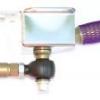Is it worth covering them in Ditrinol in-situ if not stripping it all down anyway?

Wishbone Painting....
#21

Posted 15 October 2014 - 09:46 AM
#22

Posted 15 October 2014 - 11:36 AM
I can't be arse to take all my wishbones off, but it would be nice to know what the best (read easiest!) way to protect them is without removing them. Any suggestions ?
#23

Posted 15 October 2014 - 12:05 PM
#24

Posted 15 October 2014 - 02:03 PM
Spraying the wishbones and exposed suspension bolt-threads and fasteners somewhat regularly (eg. twice a year or so) with a clear Waxoyl, Ditrinol, Tectyl (take your pick ![]() ) or other such 'waxy' coats is always a good idea.
) or other such 'waxy' coats is always a good idea.
It at least forms a first weatherproofing and moisture resisting layer. It also seals threads and joints from water ingress and reduces corrosion in those condition.
A little brake cleaner and a rag and you usually wipe it off easily.
It just looks a lot more 'icky' than a paintjob and needs semi-regular 'top up' to keep it in good shape, but it does help to reduce rust/corrosion developing.
Bye, Arno.
#25

Posted 15 October 2014 - 02:18 PM
#26

Posted 15 October 2014 - 03:19 PM
If you're half able to read German, download the catalogue from www.korrosionsschutz-depot.de. Loads of information about all the products that are available and what works and what not. Especially read the POR15 section if you plan to use that. And if you really don't mind the looks, there's always Mike Sander grease (or other greases used on ships for that same purpose, they seem to use the same formula). Used a lot for 4x4's. I always use it to stop rust in places I want to deal with later. Like my wishbones ![]() It does a very good job, but at the expense of attracking dirt like there is no tomorrow. Easy to degrease however and impossible for water to get under
It does a very good job, but at the expense of attracking dirt like there is no tomorrow. Easy to degrease however and impossible for water to get under
#27

Posted 15 October 2014 - 04:22 PM
And if you really don't mind the looks, there's always Mike Sander grease (or other greases used on ships for that same purpose, they seem to use the same formula). Used a lot for 4x4's. I always use it to stop rust in places I want to deal with later. Like my wishbones
It does a very good job, but at the expense of attracking dirt like there is no tomorrow. Easy to degrease however and impossible for water to get under
Back in 1997 I saw a test in Practical Classics of a number of anti-corrosion cavity wax treatments that claimed to be the ‘best test’. Certainly, the test was quite rigorous, and subjected the treated samples of welded angle iron to all kinds of horrors including the dreaded salt spray. The waxes were tested for their ability to penetrate seams, adhere to the bare metal or rusty surfaces, how much shrinkage they demonstrated during the drying process and finally their ability to ‘self heal’ over scratches in the protective layer. The test was carried out over 500 hours (three weeks to you and me) and the winner was…… Dinitrol 3125, with Plastic Padding and Waxoyl products coming in a close second. So was this the ‘best test’?
Being in a half-German household, and having spent nearly ten years on the continent (we are back there again after 5 years in the UK) I do read the occasional German classic car mag. Well, as if by co-incidence, one such magazine was running a similar test at the same time. However, in a predictably thorough fashion, the German test crew went a few steps further. They constructed twenty box sections with small openings at each end to simulate a car sill. These box sections were mounted on stands out in the open and sprayed internally and externally with salt-water solution on a regular basis after being treated with the various products. The samples being subjected all the time to the real conditions of outdoor life: rain, sunshine, dew and draught.
The initial test I read was conducted after one year, using an endoscope to peer into the box sections periodically and photograph the insides. The test results put the waxes tested by Practical Classics in roughly the same order, but hang on – why was Dinotrol, Waxoyl and the other waxes so far down the list?
The Germans had not only tested the common cavity waxes that we are familiar with in the UK (and which provide advertising income for the UK motoring press), but also two products that are classed as greases, not waxes and which are not easily available in the UK. Mineral wax is normally a paraffin and presumably a grease is somewhat different. Both of these products excelled in all the tests, but were far and away the only products that would ‘creep’ after application. Also being a grease with no solvent, the layer does not shrink as there is no evaporation and of course no smell afterwards (you know the smell of Waxoyl in your car? – that’s the smell of your wax layer drying, hardening and eventually cracking). The clear winner was Michael Sander’s Corrosionsschutzfett! (long word meaning rust prevention grease)
Now, I know this sounds a little beyond belief, but Herr Sander just happens to live in the next village to where we now to live in Schleswig-Holstein, and after a tour of his workshops and a look underneath two examples of customers’ cars which he had treated over ten years ago which were up on the ramps. The cars had both been treated underneath with only paint and his protective grease – it looked dirty for sure, but completely rust free. Without hesitation I sprayed 8kg of his grease into my Lancia Montecarlo in 1997, and another 8kg into my FIAT X1/9 in 2000 – both cars not famous for their anti-corrosion treatment from new. I can report that on both Italian cars I have seen ZERO deterioration in the areas that I treated. One box-section which I unfortunately missed on the Lancia was perforated within two years!
As for the test in ‘Autobild’, after FOUR YEARS of weather and salt spray, the testers showed what was left. Only the box section sprayed with Michael Sander could be removed from its stand without the steel disintegrating into a brown, crumbling mess. There was simply no competition. What more could you ask? I am a convert. And so are about 100 body shops in Germany.
So far it’s all good news, but of course there is a downside. These ‘greases’ are more or less hard at room temperature (with a consistency similar to lard) and need to be sprayed into the cavities at a temperature of at least 90° C. This not only requires special spraying equipment but also some understanding from the good lady as you heat up litres of ‘orrible grease on the hob of the newly fitted kitchen! I bought a purpose made spray pistol, thermometer and a variety of probe nozzles (including a brilliant 360 deg spray for those box sections) for about £100 and some peculiar apparatus made of cardboard tubes and an old hair-drier to pre-heat the nozzles and probes. It was fairly messy, and being hot grease you only have a few minutes per batch before it gets too hard to spray. Although having done it a few times I have plenty of helpful tips now (like, don’t do it on a cold day – it won’t work!)
Incidentally, before the hot spraying I scrubbed the wheel arches and floor clean with warm water and detergent using a variety of brushes or rags and allowed it to dry thoroughly before treating, taking care to clean up all the drain holes beforehand. Tip: always cover the entire floor area with decorator’s plastic sheeting, and tightly cover all brake discs with plastic bags and tape – I spent a lot of time on my hands and knees cleaning the garage floor with white spirit the first time!
However, a vital step before doing this work is to understand HOW the body is constructed and WHERE are the box sections. I am already planning for the later spraying of the 96 (once it is welded and painted) and due to the way the entire SAAB body is put together can only be described as strength itself, there are very few actual box sections compared to many other cars, but notably:
Sills (accessed at each end);
Front and rear spring mounts (accessed by removing rubber bung);
Rear axle tunnel (access through apertures under rear bench);
‘A’ pillars (access from beneath after removing front wing);
Scuttle/Air box (access after removing heater duct in engine bay);
Double skin section above rear wings and below rear screen (access through apertures in boot);
Box section at base of suspension ‘turrets’ (needs to be drilled and ‘bunged’ afterwards);
Shock absorber mounts (access hole and bung present);
All other areas are more or less single skin and can be reached with trim, wings or mechanicals removed.
Once prepared, treating something like a 96 sill takes around 20 seconds. Insert 360 deg probe as far as it will go. Press trigger and withdraw slowly. All surfaces inside will be coated, and if you missed a bit, just leave the car in the sun and the stuff will ‘creep’ to the bit you missed. It will also creep out of the drain holes and make marks on your driveway for the first year! (Have you ever been sitting behind a Mk2 VW Golf and wondered why it has two symmetrical greasy streaks on the rear valence below the tail-gate; yes they use something similar at Wolfsburg, and it leaks out of the hatch in hot weather too)
#28

Posted 26 December 2015 - 08:42 PM
Does anyone know what the wishbone is made off? I'm assuming mild steel but is it a tube or a solid bar?
If not treated should we be expecting our wishbones to snap anytime soon?
#29

Posted 26 December 2015 - 08:51 PM
#30

Posted 27 December 2015 - 08:57 AM
Powder coating is definitely not a good long term process because it can hide untold horrors which, when finally discovered, may mean the 'protected' item has deteriorated beyond repair. Hot dip galvanising is great for protection but may not be straightforward to do on closed tubes as previously described, and will probably require cleaning up, reaming etc after treatment. For wishbones we always used to Cadmium plate and passivate but when Cad became an illegal heavy metal we went to Zinc plate and passivate, probably just as good. Spray them from time to time with something oily or waxy and they will probably last forever! The huge advantage of plating is that any new corrosion is visible practically from the outset and can be caught early, particularly important when you bear in mind that the wishbones are fabricated from relatively thin wall tube.
#31

Posted 27 December 2015 - 09:49 AM
Interesting. What do you think of these zinc based undercoats like they've just used on the Forth Rail Bridge?
#32

Posted 27 December 2015 - 12:06 PM
Don't know much about this type of process but I'm sure it works well for a bridge, a massive structure which is repainted on a regular basis. I guess the objective is to keep surface corrosion under control as it would be impossible to keep a structure that size totally rust free, also it is enormously over specified by comparison with our wishbones! The thing about plating and passivating is that it is very easy to see new corrosion should any occur, nothing covering it up, but it is still a really good protective coating for the steel underneath.
#33

Posted 27 December 2015 - 12:20 PM
It's not meant to require repainting on a regular basis. They say it shouldn't need any re-painting for a miniumum of 25 years.
#34

Posted 27 December 2015 - 06:12 PM
Well, as I say, I'm sure it's great for bridges but personally I'd prefer to stick with the process that has demonstrated itself, over many years, to be very good in this particular application. Lots of different processes have been tried, phosphating, galvanising, plating and painting, and zinc plating plus passivating is the one that I think most would agree is the best compromise. Bear in mind too that bridges are made up of parts mostly far too big to go in any hot dip bath so you are left with only those coatings that can be sprayed or painted and, whilst they may be capable of lasting 25 years I know that on the Firth of Forth bridge they start again at the beginning as soon as they finish the painting the previous coat!
#35

Posted 27 December 2015 - 06:28 PM
No question about plating processes - I'm a big fan, but this is now a myth.
I know that on the Firth of Forth bridge they start again at the beginning as soon as they finish the painting the previous coat!
http://www.bbc.com/n...t-fife-16110496
Painting has finished.
....for a while.
#36

Posted 27 December 2015 - 08:21 PM
That looks really interesting, I stand corrected but it is a new product it says, perhaps the old stuff needed doing more often! Also says it's glass flake epoxy so will it stand up to stone impacts and how do you remove it if it does get damaged and needs recoating? Last point, would you need to ream before installing the bushes etc? I'm probably being too conservative but there is always the risk that if you are the first you may hit problems unforeseen when there is actually nothing much wrong with the traditional treatments!
#37

Posted 27 December 2015 - 11:19 PM
Is that the stuff that caused the bridge's structural problems? ![]()
#38

Posted 28 December 2015 - 07:42 AM
#39

Posted 28 December 2015 - 08:59 AM
#40

Posted 28 December 2015 - 10:46 AM
Have a look at Zinc Nickle plating - It is an electroplating process just the same as normal zinc plating but it has around 5 times the corrosion resistance
0 user(s) are reading this topic
0 members, 0 guests, 0 anonymous users























